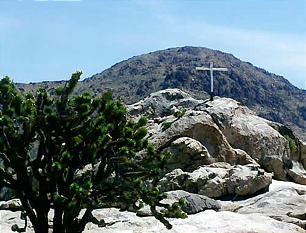





Bulletin 11 May 2010 - Mojave National Preserve, California
The seven-foot-tall metal "Mojave Cross" has disappeared, apparently removed by vandals some time during the night of 9-10 May 2010.
April 2010 - Washington, D.C.
In a judgment of potential significance for future U.S. church-state disputes, the Supreme Court of the United States has ruled that a California federal court went too far in ordering the removal of a war memorial cross long displayed on federal land in a remote area of the California desert. The 5-4 opinion of 28 April 2010 in Salazar v. Buono concerned the 5-foot-tall cross erected in 1934 by the Veterans of Foreign Wars on Sunrise Rock in the Mojave National Preserve. In 2002 a district court enjoined the display. The U.S. Congress responded swiftly with legislation in late 2002 and in 2003 barring the use of federal funds to dismantle World War I memorials and suggesting a land exchange that could have left the cross standing on private ground. Seeing these acts as government evasion of the constitutional issue, the Ninth Circuit Court of Appeals in 2004 affirmed the district court's injunction and moved to enforce it. During this process and while awaiting the outcome of the writ of certiorari to the Supreme Court, the cross has been covered by a plywood box.
Six justices wrote separate opinions in the April 2010 decision, none for the majority. Chief Justice John Roberts joined the majority opinion of Justice Anthony Kennedy, who wrote, "Here one Latin cross in the desert evokes far more than religion. It evokes thousands of small crosses in foreign fields marking the graves of Americans who fell in battles, battles whose tragedies are compounded if the fallen are forgotten. ... The goal of avoiding governmental endorsement does not require eradication of all religious symbols in the public realm."
Writing in dissent, Justice John Paul Stevens agreed that soldiers who died in battle deserve a memorial to their service. But the government, he said, "cannot lawfully do so by continued endorsement of a starkly sectarian message."
One proposed solution was that the government remove the cross, sell the land, and re-erect the cross. "I do not see how it can make a difference for the government to skip that empty ritual and do what Congress told it to do — sell the land with the cross on it," said Chief Justice Roberts. Justice Stevens argued that the land transfer could itself be considered a promotion of religion. If the land had been privately owned to begin with, he wrote, there would be no question that the statue is permissible under control of the veterans.
"But the Government does own this land, and the transfer statute requires the executive branch to take an affirmative act — transfer to private ownership — designed to keep the cross in place," Stevens wrote, joined by Justices Sonia Sotomayor and Stephen Breyer.
Justice Kennedy, even as he took part in the opinions of the majority, insisted that the ruling does not provide a clear rule for the future and did not even explicitly say that the cross could remain in place. "To date, the court’s jurisprudence in this area has refrained from making sweeping pronouncements, and this case is ill suited for announcing categorical rules,’" said Justice Kennedy.
